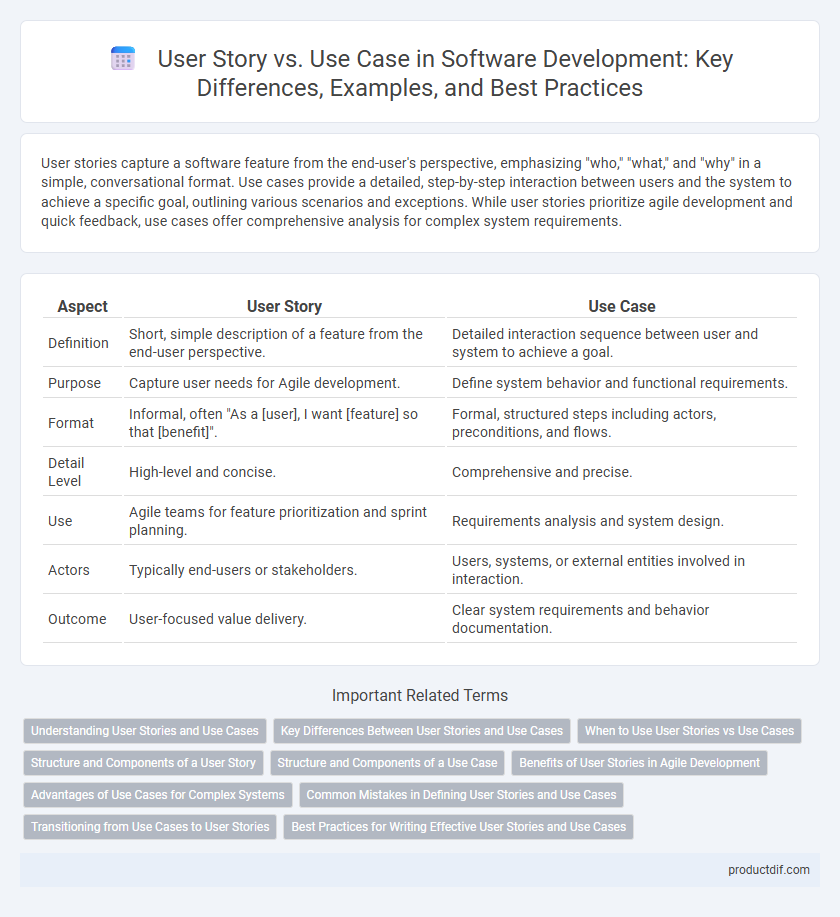User stories capture a software feature from the end-user's perspective, emphasizing "who," "what," and "why" in a simple, conversational format. Use cases provide a detailed, step-by-step interaction between users and the system to achieve a specific goal, outlining various scenarios and exceptions. While user stories prioritize agile development and quick feedback, use cases offer comprehensive analysis for complex system requirements.
Table of Comparison
| Aspect | User Story | Use Case |
|---|---|---|
| Definition | Short, simple description of a feature from the end-user perspective. | Detailed interaction sequence between user and system to achieve a goal. |
| Purpose | Capture user needs for Agile development. | Define system behavior and functional requirements. |
| Format | Informal, often "As a [user], I want [feature] so that [benefit]". | Formal, structured steps including actors, preconditions, and flows. |
| Detail Level | High-level and concise. | Comprehensive and precise. |
| Use | Agile teams for feature prioritization and sprint planning. | Requirements analysis and system design. |
| Actors | Typically end-users or stakeholders. | Users, systems, or external entities involved in interaction. |
| Outcome | User-focused value delivery. | Clear system requirements and behavior documentation. |
Understanding User Stories and Use Cases
User stories capture specific user needs and desired functionality in a concise, informal format, typically following the "As a [user], I want [feature], so that [benefit]" template. Use cases provide a detailed, structured narrative describing interactions between an actor and the system to achieve a goal, highlighting step-by-step flows and alternate paths. Understanding the distinction helps software teams prioritize development, improve communication, and ensure requirements align with user expectations.
Key Differences Between User Stories and Use Cases
User stories emphasize simplicity and user perspective, capturing requirements as brief, informal descriptions usually written in the format "As a [user], I want [goal] so that [reason]." Use cases provide a detailed, structured approach, outlining step-by-step interactions between users and the system to achieve a specific goal, often including alternative flows and exceptions. User stories prioritize flexibility and rapid iteration in agile environments, while use cases offer comprehensive documentation suited for thorough analysis and complex systems.
When to Use User Stories vs Use Cases
User stories are best suited for agile environments where iterative development and rapid feedback cycles prioritize customer needs and evolving requirements. Use cases provide detailed functional specifications ideal for projects requiring comprehensive documentation, complex system interactions, and stakeholder alignment. Choosing user stories supports flexibility and collaboration in product backlog management, while use cases enhance clarity in system design and requirements analysis.
Structure and Components of a User Story
A User Story consists of three primary components: a user role, a goal or desire, and the benefit or value of achieving that goal, often structured as "As a [user], I want [action], so that [benefit]." Unlike Use Cases, which include detailed scenarios, flowcharts, and alternative paths, User Stories emphasize a concise format that facilitates agile development and prioritization. Key elements such as acceptance criteria and conversation notes enhance clarity and ensure alignment between stakeholders and developers.
Structure and Components of a Use Case
A use case is structured around key components including actors, preconditions, main success scenarios, extensions, and postconditions, providing a detailed narrative of system interactions from the user's perspective. Each use case begins by identifying the primary actor who initiates the process, followed by a sequence of steps outlining the system's responses and variations for alternate flows or exceptions. This structured format supports clear communication among stakeholders and facilitates comprehensive requirements gathering and system design.
Benefits of User Stories in Agile Development
User stories in Agile development enable teams to capture requirements in a simple, user-focused format that fosters collaboration and adaptability. They promote iterative progress by breaking down features into manageable tasks, which helps prioritize work according to user value and business goals. This approach enhances communication between developers and stakeholders, resulting in faster feedback cycles and more aligned, customer-centric software delivery.
Advantages of Use Cases for Complex Systems
Use cases provide a detailed, step-by-step framework that captures complex system interactions, making them ideal for modeling intricate workflows and multiple user roles. They enhance communication among stakeholders by offering clear scenarios that map system behavior, reducing ambiguity in requirements. This structured approach supports thorough validation and testing, ensuring comprehensive coverage of all functional aspects in complex software systems.
Common Mistakes in Defining User Stories and Use Cases
Common mistakes in defining user stories include vague acceptance criteria and neglecting user roles, which lead to ambiguous requirements and ineffective deliverables. In use cases, errors often arise from overcomplicated scenarios and lack of clear actors, causing confusion in system interactions and test design. Properly distinguishing user stories' focus on user needs from use cases' emphasis on system behavior enhances clarity and project alignment.
Transitioning from Use Cases to User Stories
Transitioning from use cases to user stories involves shifting from detailed, step-by-step scenarios to concise, value-driven requirements focused on user goals. Use cases offer comprehensive workflows and system interactions, while user stories emphasize simplicity, collaboration, and iterative development in agile environments. This transition improves adaptability, prioritizes user needs, and accelerates feedback cycles during software development.
Best Practices for Writing Effective User Stories and Use Cases
Effective user stories prioritize clear, concise language centered on user goals and benefits, typically following the format "As a [user], I want [feature] so that [value]." Use cases are best developed by detailing specific interactions between actors and systems, emphasizing alternative flows and exceptions to cover comprehensive scenarios. Both approaches benefit from iterative refinement, collaboration with stakeholders, and validation through real-world testing to ensure alignment with user needs and system requirements.
User Story vs Use Case Infographic

 productdif.com
productdif.com